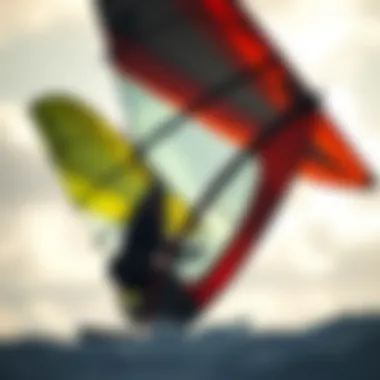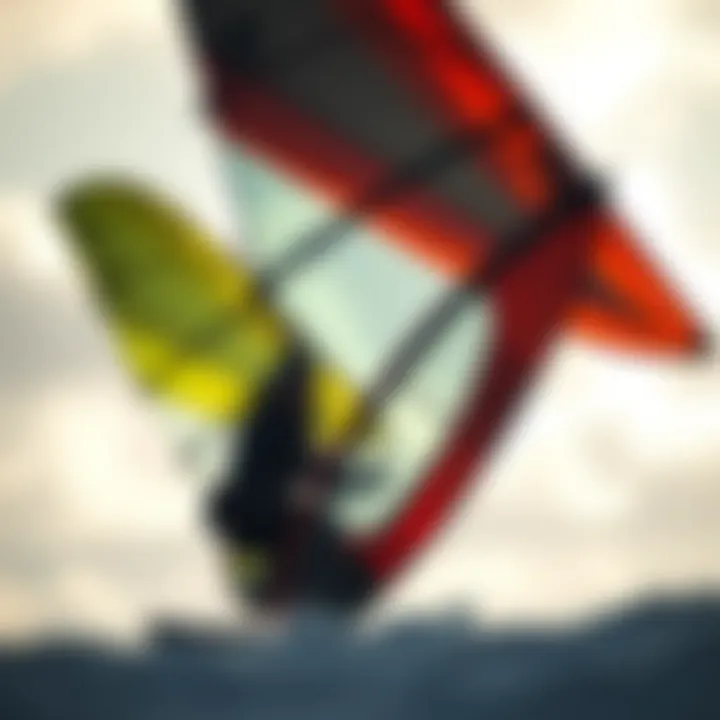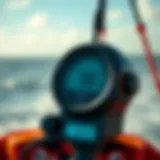Understanding Wing Foil Pricing and Cost Factors


Intro
Wing foiling has surged in popularity among water sports enthusiasts, blending the thrill of surfing with the dynamism of kiteboarding. However, the pricing of wing foils can be as varied as the styles of riders themselves. Understanding the variability in costs is essential for anyone venturing into this engaging sport. Elements like brand reputation, material quality, and performance characteristics play substantial roles in determining how much one can expect to pay for a wing foil setup.
The prices can fluctuate significantly due to various factors. It’s not just about picking a color or a design; it's about delving into the capabilities, material composition, and technology behind each piece of equipment. For those new to kiteboarding or seasoned veterans looking to upgrade, grasping the nuances of wing foil pricing will arm you with the knowledge you need to make a wise investment. In this guide, we will explore the detailed facets of wing foil pricing, analyzing both budget-friendly options and premium choices.
Gear and Equipment
When preparing to take to the water, having the right gear is paramount. This section focuses on the essential equipment needed for both novices and experienced riders.
Essential Kiteboarding Gear for Beginners
For those just dipping their toes in wing foiling, simplicity and reliability are key. Here’s a closer look at the gear you might consider investing in:
- Wing Foil: A beginner-friendly wing, often softer and a little larger to allow for easier control; brands such as Slingshot and Duotone offer great entry-level options.
- Foil Board: Look for a stable board with cushioned foot straps; wider boards help with balance while mastering the art of riding.
- Safety Gear: Always include a helmet and impact vest to protect yourself against falls and mishaps.
- Adjustable Harness: Simple yet effective, a harness will help you maintain stability without straining your arms.
In terms of pricing, beginners can expect to spend anywhere between $900 to $1,500 for a decent setup. This is a significant investment considering the enjoyment and exhilaration that comes once you hit the waves.
Advanced Equipment for Experienced Riders
As you progress, so does your need for specialized gear. Competitive riders often look for equipment that enhances performance and suits their individual styles. Consider these key components:
- High-Performance Wings: Brands like F-One and Naish offer wings designed for speed and agility, typically priced higher due to advanced engineering and materials, often ranging from $1,300 to $2,000.
- Foils for Speed: Carbon foils are favored for their lightweight and durability although they come with a heftier price tag.
- Customizable Boards: Advanced riders often want boards tailored to their style, which can get pricey but is worth it for performance aficionados.
For experienced kiteboarders, laying out anywhere from $2,500 to $4,000 for high-end gear is not uncommon. Investing in specialized equipment can drastically affect performance, making every penny count.
"Choosing the right gear isn't just about affordability; it’s about enhancing your experience and pushing the limits of your performance."
By understanding the spectrum of wing foiling gear available, from beginner setups to bespoke advanced equipment, kiteboarding enthusiasts can make educated choices that meet their riding aspirations and budgets. In the next sections, we will dive deeper into various factors that influence these costs, providing you with insights to maximize your value as you navigate the exhilarating world of wing foiling.
Prolusion to Wing Foils and Their Pricing
The world of water sports has seen an exhilarating transformation with the emergence of wing foiling. This sport combines elements of surfing, kiteboarding, and windsurfing. As new enthusiasts dive into this adventure, understanding wing foils and their pricing structure becomes crucial. Knowing what you’re paying for can shape your experience on the water.
Defining Wing Foils
Wing foils are specialized equipment that consists of a wing and a foil attached to a board. At a glance, the wing resembles a handheld parachute, harnessing wind power for propulsion. The foil, submerged beneath the water, lifts the rider above the surface, allowing for smooth gliding. The setup is designed to provide thrill and ease of use, which has sparked interest among both seasoned athletes and novices alike.
When considering wing foils, it's essential to notice various types available in the market. Ranging from inflatable options to rigid models, each type caters to different skill levels and preferences. These variations impact not only the performance in the water but also the overall cost.
Importance of Pricing in Equipment Selection
Pricing is a pivotal factor when exploring wing foils. For many, it sets the tone for selection and purchasing decisions. A higher price often correlates with enhanced features, superior materials, and advanced technology integrated within the equipment. However, it’s worth noting that not all costly options guarantee the best performance for every individual.
Selecting the right gear within a budget requires a delicate balance of quality and value. Below are key considerations:
- Performance Needs: Riders with lofty ambitions might invest more upfront for a professional setup.
- Beginner Focus: Newcomers may opt for budget-friendly options until they grasp the basics. Investing heavily from the get-go could lead to regret if the sport does not resonate.
- Long-Term Use vs. Immediate Satisfaction: Some may prioritize flashy features while others think pragmatically about durability and long-term investment.
"Understanding wing foil pricing is as important as the technique you use on the water. Choose wisely!"
In essence, grasping the significance of pricing will empower you, as a rider, to make informed decisions that enhance your wing foiling experience. Knowing what’s behind the price tags helps ensure that your choice aligns with your skill level and aspirations.
Factors Influencing Wing Foil Prices
When it comes to wing foil pricing, understanding the various elements at play can make all the difference for enthusiasts and collectors alike. Each component contributes to the total cost, shaping the purchasing decisions of all who seek thrill and adventure on the water. Factors such as material quality, brand reputation, and the technological innovations incorporated into the equipment not only define cost but also impact performance and longevity. This section delves into these factors to provide a clearer picture of what drives pricing in the wing foil market.
Material Quality and Costs
The materials used in constructing wing foils are pivotal to their performance and durability. Generally, manufacturers use a combination of high-quality fabrics, lightweight composites, and durable foams. It is essential to realize that the cost of these materials can vary significantly. For instance, a wing made from top-grade carbon fiber will inevitably cost more than one made from standard aluminum components.
- Durability: Foils that are built with superior materials often last longer and withstand harsher conditions, justifying the higher price tag.
- Lightweight Design: Manufacturers craft wings using lighter materials to facilitate better performance. This extra attention to weight can result in a noticeable price increase, especially with cutting-edge designs.
The balance between affordability and performance is delicate. For those on a budget, finding a reliable wing made from slightly lower-cost materials can provide a satisfactory experience without breaking the bank. However, opting for budget options might come with trade-offs in terms of performance and lifespan.


Brand Reputation and Market Positioning
Brand reputation plays a significant role in determining wing foil prices. Established brands often command higher prices because they have built a name for themselves through consistent quality and customer satisfaction. When consumers see a reputable name on a foil, they are more likely to trust the quality.
On the other hand, newer or lesser-known brands might offer more competitive pricing to penetrate the market but sometimes lack the proven track record of their competitors. Considerations include:
- Customer Service: Established brands usually provide robust customer support, warranty options, and return policies, which can enhance the perceived value.
- Research and Development: Well-known companies often invest in R&D, leading to innovations that can significantly improve the riding experience, thus validating a higher price point.
Navigating between brand prestige and cost can be tricky; however, it’s crucial to focus not just on the name but also on the specific characteristics of each wing.
Technological Innovations and Features
The technological advancements in wing foil design can dramatically affect pricing. Features such as specialized wing shapes, adjustable struts, and advanced pumping systems contribute to enhanced performance but also add to production costs. These innovations address various riding conditions and user preferences, ranging from recreational to competitive riders.
Some notable innovations influencing price include:
- Hydrodynamic Shapes: Enhanced wing designs improve lift and control, providing riders with a more exhilarating experience.
- Inflatable Versus Rigid Construction: The type of construction also has a say in cost; inflatable wings are generally more portable but may not offer the same performance as rigid wings.
As new technologies emerge, prices may fluctuate. Desire for cutting-edge features can lead to increased spending, proving that innovation and excitement often come at a cost.
Comparative Price Analysis Across Brands
Understanding the pricing of wing foils across different brands is essential for anyone considering a purchase. This comparative price analysis reveals more than just numbers; it sheds light on the nuances of brand reputation, product quality, and the expected performance of the equipment. Each brand carries its own identity, and this identity significantly influences pricing strategies. Therefore, grasping these differences offers valuable insights for enthusiasts and potential buyers.
When it comes to wing foils, selecting the right product often boils down to the balance between budget and performance. High-end brands might tout advanced engineering, while budget options often catch the eye with accessibility and lower price tags. With this in mind, it’s important to measure the long-term value of your investment rather than just the initial cost. A deeper understanding of what each brand represents can guide a buyer towards making a more informed decision and potentially avoiding the pitfalls of regret.
High-End Brands vs. Budget Options
High-end brands are often viewed as the gold standard in the wing foil market. Products from leading manufacturers frequently incorporate cutting-edge materials and innovative design features that can significantly enhance an athlete's experience on the water. Brands such as Duotone or Naish command higher prices due to their reputation built on extensive research, quality assurance, and premium materials. These brands often adopt rigorous testing protocols, ensuring their products perform consistently under various conditions.
Pros of high-end brands include:
- Enhanced Performance: Greater efficiency in lift and stability.
- Durability: Made from high-quality materials that withstand wear and tear.
- Cutting-Edge Technology: Incorporation of the latest advancements, enhancing user experience and safety.
On the flip side, budget options provide a more accessible entry point for novice kiteboarders or those who may not want to invest heavily at the start. Brands such as Slingshot or Ozone, while less expensive, can still deliver decent performance for casual riders or learners. Saving money doesn’t always mean compromising quality, as some budget brands cater to those new to the sport, providing affordable yet functional gear.
In terms of price, here’s a quick rundown:
- High-End Wing Foils: Typically range from $1,200 to $2,500.
- Budget Wing Foils: Can be found between $500 and $1,200.
Ultimately, the choice between a high-end brand or a budget option boils down to the user's experience level, intended use, and budget allocated for gear.
Market Trends and Their Impacts
In the world of wing foiling, price trends can fluctuate significantly based on a mix of market demand, economic conditions, and new technological advancements. Recently, a surge in interest for water sports has seen increased spending on equipment, leading to a rise in wing foil prices. Seasonal demand often plays a crucial role—during peak summer months or holiday seasons, prices can skyrocket due to heightened consumer interest and supply constraints.
This trend showcases the relationship between supply chain dynamics and pricing. Manufacturers are pressured to keep up with demand, and this could lead to potential increases in retail prices. Additionally, economic factors such as inflation can indirectly influence consumer prices in outdoor sporting goods, making awareness of current market trends critical for potential buyers.
"Understanding market trends not only helps consumers anticipate price shifts but also empowers them to make smarter purchasing decisions."
By staying informed about the movements within the market, enthusiasts can discern the best times to buy, optimizing their chances of securing the necessary gear without breaking the bank. Furthermore, engaging with online communities through platforms like Reddit or specialized forums can uncover firsthand insights and recommendations based on latest trends and personal experiences.
Understanding the Cost Range
In the realm of wing foiling, determining an appropriate cost range for equipment becomes a keystone in the decision-making process for many enthusiasts. The prices of wing foils can vary dramatically, influenced by several factors including quality of materials, brand reputation, and the features offered. Understanding the cost range not only aids buyers in making informed choices but also helps them align their expectations with their budget and performance needs.
The landscape of prices often reflects the tiers of products available. Buyers must sift through entry-level options suitable for beginners to high-end models meant for more seasoned riders. Establishing this range ensures that individuals can find gear that meets their skill level while providing value for money.
Key considerations include:
- Assessing personal skill level: Different foils cater to varying abilities, thus impacting one's choice and subsequent pricing.
- Longevity vs. initial investment: A cheaper model may be appealing upfront but might not endure heavy usage compared to a pricier, robust model.
- Performance specifications: Higher-priced items often come with advanced features that might be essential for certain riders.
Entry-Level Wing Foils: Features and Pricing
Entry-level wing foils typically occupy the lower segment of the pricing spectrum, making them attractive for beginners who are just dipping their toes into this sport. The average cost for these models usually falls between $600 and $1,200. Generally speaking, these foils come with essential features designed to ease learners into the sport without overwhelming them with excessive technical specifications.


Common characteristics of entry-level wing foils include:
- Lightweight construction: Made from durable yet light materials that facilitate easier handling and less fatigue during use.
- Stable performance: A design aimed at providing stability that allows beginners to feel more secure while learning.
- Moderate size: Typically larger sizes help ensure better lift and easier starting for newcomers.
Riders may encounter brands like Naish or Slingshot here, as they often provide solid entry-level options renowned for their dependability.
Mid-Range and Advanced Models: What to Expect
In contrast, the mid-range and advanced wing foils command a price range from about $1,200 to $2,500 and above, depending on specific brands and models. These foils are tailored for those looking for higher performance, exploration of different wind conditions, and the desire for a more dynamic riding experience.
Features to expect in these higher-tier models are:
- Advanced materials: Utilization of carbon fiber and other high-tech composites that offer lightweight strength and greater responsiveness.
- Technical refinements: Many of these foils incorporate innovations like improved foot strap placements and wing shapes optimizing aerodynamics, essential for more serious riders.
- Customized designs: Options for specific weight capacities and riding styles allow enthusiasts to tailor their gear according to personal preferences.
Brands noted for their mid-range and advanced products include F-One and Duotone, known for producing some of the leading models in competitive and recreational wing foiling.
By comprehending the cost range and the corresponding features of various wing foil categories, consumers can select gear that not only fits their budget but also complements their individual riding aspirations.
Budget Considerations for Enthusiasts
When it comes to diving into the world of wing foils, keeping an eye on the budget is paramount. Wing foils can vary widely in price, and understanding how to make your dollars stretch is crucial for both rookies and seasoned veterans. It isn't merely about picking the cheapest option; it's about finding equipment that balances quality and cost-effectiveness. Making informed financial decisions can help you enjoy the sport without breaking the bank.
Setting a Realistic Budget for Gear
Establishing a clear financial plan before purchasing gear is the first step. Begin by assessing your current situation, including how often you plan to use the equipment and your level of commitment to the sport. For beginners, a common pitfall is to overspend on high-end gear without fully understanding their needs.
Consider several factors:
- Usage Frequency: If you plan to ride regularly, investing a bit more in durable and efficient gear can pay off in the long run.
- Skill Level: Newcomers might benefit from entry-level options that allow them to progress without significant financial risks. Advanced riders may lean towards specialized models tailored for performance.
- Other Expenses: Don’t forget about associated costs like transportation, maintenance, and insurance. These can add up quickly!
Having a budget in mind will also guide you when comparing various models and brands. Sometimes, snagging a deal on last year’s model can yield substantial savings.
Long-Term Investment vs. Immediate Needs
When deciding on your wing foil purchases, weighing short-term needs against long-term goals is a smart move. It is easy to get swept away by the allure of top-tier equipment, but one must also consider how such a choice aligns with future plans in the sport.
- Immediate Needs: If you're just starting out, shelling out a hefty sum on premium gear might not be necessary. A solid, well-priced foil that fits your learning curve could be enough to get you started.
- Long-Term Goals: Down the line, as your skills develop, you may want to upgrade to equipment that offers better performance. Investing wisely in decent quality gear now could prepare you for your future in wing foiling.
In summary, think carefully about both present circumstances and where you envision yourself in the future. This consideration will not only save money but also enhance your experience.
"A penny saved is a penny earned," and strategic planning can pave the way for both enjoyment and financial prudence in the world of wing foiling.
Evaluating Value for Money
When diving into the realm of wing foils, understanding value for money is crucial for both seasoned veterans and newcomers. This doesn’t merely revolve around the number stamped on a price tag; rather, it encompasses various apparent and hidden factors that come together to paint a full picture of the investment you’re about to make.
One primary consideration in assessing the value for money is recognizing the relationship between performance and cost. Just because a wing foil comes with a hefty price doesn’t necessarily mean it will outperform its less expensive counterparts. Enthusiasts often find that a model rich in features and technology can significantly enhance their experience on the water. However, this enhancement must justify the price; otherwise, it’s just a waste of cash.
In addition, the comparative longevity and durability of the equipment affect the cost-benefit analysis. A higher upfront cost might seem burdensome, yet if the product lasts several seasons, that initial sting can transform into a savvy financial decision over time.
Performance vs. Price: Making Sense of the Balance
Finding the sweet spot between performance and price can feel like searching for a needle in a haystack, especially when the market is bursting with options. Essentially, one must evaluate what performance metrics matter the most. Are you after speed, stability, or maneuverability? Each feature tends to come with differing costs.
- Speed: Models designed for speed often utilize advanced materials and technology, which might throw your budget out the window but offer an exhilarating experience.
- Stability: If you're more inclined to enjoy a relaxed ride, stability could take precedence. Many affordable models focus on this aspect, catering to those who prefer easy handling.
- Maneuverability: This plays a significant role for adventurous kitesurfers and freestyle enthusiasts. If you find yourself often flipping or playing in the waves, investing in a featherweight foil with design tweaks might be worth the splurge.
Balancing these features against costs comes down to personal preferences and intended use. A seasoned waterman might skip on a budget foil only to realize its poor performance during a rough session, while a casual weekend warrior may find that less expensive options suit them just fine.
User Reviews and Recommendations
In the digital age, user experiences play a pivotal role in shaping perceptions about any product. When it comes to wing foils, online platforms like Reddit and reviews on dedicated kiteboarding websites serve as goldmines of information. By taking time to sift through user recommendations, potential buyers can unearth insights that might not make it to marketing brochures.
- Actual Performance Feedback: Often, users share their firsthand experiences about how well a specific wing foil performed under various conditions—like strong winds versus calm days.
- Durability Insights: Frequent riders provide valuable input on the wear and tear of models. They often highlight construction flaws that manufacturers might overlook in their glossy ads.
- Tips on Use: Enthusiasts might throw in nuggets of advice on how to get the most out of your purchase, often emphasizing setups, wing size, or compatible components. It’s like having a backyard barbecue with seasoned riders spilling secrets based on trials and errors.
It’s wise not to get swayed by a few glowing recommendations alone. Sometimes, even the most praised gear might not hold up to scrutiny for your specific needs. Therefore, combining user reviews with comparisons and professional opinions is the surest way to home in on your ideal wing foil.


"The best wings are those that find the balance between what you spend and what you get. Analyze thoroughly and make informed choices!"
This value for money analysis ultimately informs a purchase that aligns with your riding goals, skill level, and budget—creating a more enjoyable experience on the water.
Defined Features and Their Costs
Understanding the various features that contribute to the pricing of wing foils is crucial for any potential buyer. Features like wing size and construction type not only influence how much one will spend but also determine the overall performance and experience in the water. For enthusiasts navigating the diverse range of options, grasping these aspects can spell the difference between an exhilarating ride and a frustrating outing.
Wing Size and Performance Implications
When it comes to wing foils, size truly matters. Larger wings, for instance, tend to provide more lift, making them ideal for lighter winds or those just beginning their journey into wing foiling. In contrast, smaller wings are better suited for high winds and more advanced maneuvers. Pricing becomes heavily interconnected with wing size; typically, larger wings come with a price tag that reflects the additional material and specialized designs necessary for excellent performance.
- Lift and Stability Requirements: Investing in a larger wing might cost more, but it offers added lift and stability, which can be beneficial for beginners.
- Maneuverability Considerations: Smaller wings are often preferred by experienced riders for their agility, translating to a more dynamic ride, albeit at a lower price point for the actual wing.
One must consider the sailing conditions and personal skills when selecting wing size. A choice made without proper foresight can lead to unnecessary expenses or dissatisfaction. Therefore, weighing the balance between size, skill level, and cost becomes essential to achieving an optimal purchase decision.
Construction Type: Inflatable vs. Rigid
The construction type of a wing has a profound effect on pricing and performance. The two principal types, inflatable and rigid, serve distinct purposes and user preferences:
- Inflatable Wings: These tend to be lighter and more portable. When fully inflated, they offer solid performance with good stability in moderate conditions. However, they may lack the same level of responsiveness and rigidity seen in their hard counterparts. Their prices tend to be on the lower end of the spectrum, making them an appealing option for those less experienced or those looking to save money.
- Rigid Wings: On the other hand, rigid wings, often constructed from materials like carbon fiber or high-density foams, can deliver superior performance. They offer excellent stiffness, leading to enhanced speed and maneuverability. However, this performance comes at a cost; these wings typically command a higher price due to the advanced materials and manufacturing techniques involved.
Cost considerations don't just stop at the purchase price. Maintaining wings, repairing minor damages, and the durability of different materials can add to the long-term costs associated with each type of wing. Buyers should carefully weigh these factors and expectations before committing to either inflatable or rigid constructions.
"Selecting the right wing foil construction could mean the difference between exhilaration and frustration on the water."
In summary, the features of wing foils play a direct role in determining their costs. Understanding the implications of wing size and construction type can equip enthusiasts with better insights for making informed purchasing decisions, allowing them to appreciate the adventure while minimizing potential pitfalls related to equipment."
Trends in Wing Foil Pricing
Understanding trends in wing foil pricing is crucial for anyone involved in the sport, whether they are seasoned kiteboarders or weekend warriors. Prices fluctuate for a variety of reasons, and recognizing these patterns helps enthusiasts make informed purchasing decisions. Over time, these trends can illustrate a broader narrative regarding materials, technological advancements, and consumer behaviors.
Impact of Supply Chain on Prices
The supply chain plays a pivotal role in dictating wing foil prices. As consumer demand surges and production ramps up, the dynamics of supply chains become increasingly complex. Hardware, such as foils, wings, and boards, often requires a mix of high-quality materials and labor, which can lead to variance in prices. For instance, if a certain resin or fabric becomes scarce either due to natural disasters or geopolitical issues, manufacturers may face accelerated costs, with these usually trickling down to consumers.
The logistics of transporting these materials also contribute to price variability. Rising fuel costs, delays at ports, and tariff changes can all lead to an increase in the final retail price. Suppliers aiming to minimize costs might opt for cheaper materials, compromising product quality. Thus, keeping an eye on global supply chain trends, from raw material sourcing to shipping routes, is essential for predicting pricing changes over time.
"Global supply dynamics inevitably influence local pricing – and wing foils are no exception."
Seasonal Pricing Variations
Like many sports equipment, wing foil prices exhibit seasonal variations. Typically, the demand peaks during spring and summer months as enthusiasts flock to the water. Higher demand can lead to inflated prices, especially for new models from top brands. Retailers often offer discounts in the off-season to clear out inventory, which can provide savvy shoppers with a chance to snag a good deal.
Moreover, end-of-season sales can mean significant savings. Keeping an eye out for promotions during these times can yield high-quality gear at a fraction of the price.
When planning purchases, it's beneficial for buyers to be aware of these cyclical price changes. Analyzing market trends and seasonal demand alongside local climate conditions can illuminate the best times to invest in wing foils. The goal is to pinpoint the ideal moment to secure quality equipment without breaking the bank.
Future Pricing Predictions
As we look ahead in the realm of wing foils, understanding future pricing predictions is essential for anyone involved in the sport. Price forecasting not only assists potential buyers in making informed investment decisions but also sheds light on market dynamics that could affect the availability and cost of wing foils in the coming years. Some of the key aspects that influence these future predictions include evolving consumer trends, advancements in technology, and changes in material sourcing.
The ever-fluctuating market demand, which can sway prices like a kite in the wind, underscores the significance of keeping an eye out for industry shifts. Factors such as the rise of eco-conscious consumers might urge brands to diversify their offerings, potentially impacting pricing structures. Moreover, as the technology surrounding wing foiling progresses, we might see premium products that once commanded high prices start becoming more accessible, altering the financial landscape for the community.
Potential Influences of Market Demand
Market demand plays a pivotal role in predicting future prices of wing foils. When enthusiasm for the sport is at its peak, prices tend to ascend as well, often driven by consumer competition and limited supply. Conversely, when interest wanes, manufacturers may need to adjust their prices to attract buyers. The cyclical nature of this demand makes it crucial for enthusiasts and industry stakeholders to remain adaptable and informed.
- Seasonal spikes in sales due to holidays or significant events in the kiteboarding community can create fluctuation in prices.
- Additionally, trends in recreation and fitness influence sales; for instance, a surge in adventure tourism could see demand for wing foils spike, thus raising prices due to increased consumer interest.
Evolution of Materials and Manufacturing
The evolution of materials and manufacturing technology is another critical component affecting wing foil pricing. As production methods become more efficient, the costs tied to manufacturing can potentially decrease, reflecting lower prices in the market. Innovations in lightweight materials, such as high-strength polymers and composites, not only enhance performance but may also alter the cost equation significantly.
Adoption of sustainable practices, like using recycled materials, is gaining traction as consumers become more environmentally conscious. Though this might lift production fixed costs initially, in the longer run, it can lead to a stabilization of prices as eco-friendly materials become more commonplace.
In summary, keeping a tab on market dynamics and advancements in materials and manufacturing can help kiteboarding enthusiasts not just prepare for their next purchase but also understand the broader industry landscape. Whether you're a seasoned rider or just starting out, being aware of these factors can offer an edge when navigating the intricate world of wing foil pricing.
"The best way to predict the future is to invent it."
For further information, you can explore resources such as: Wikipedia on Kiteboarding, Britannica on Kitesurfing, and community discussions on Reddit regarding buying and maintaining gear.



